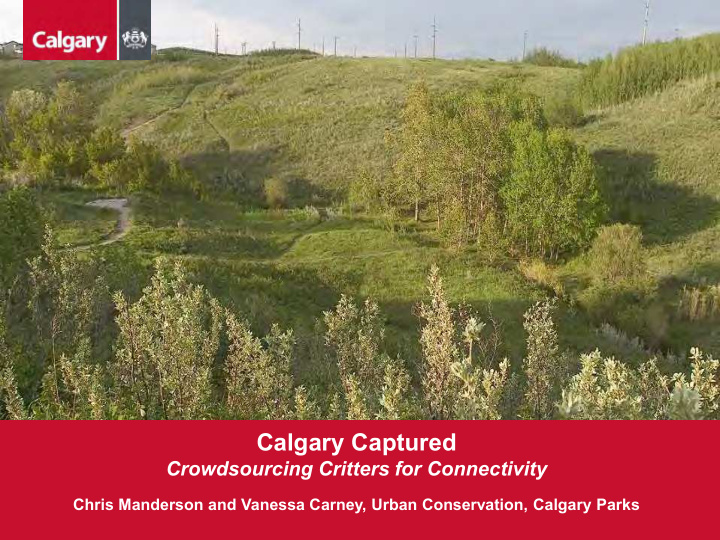



Calgary Captured Crowdsourcing Critters for Connectivity Chris Manderson and Vanessa Carney, Urban Conservation, Calgary Parks V04
Parks and Biodiversity V04
Biodiversity Strategic Plan (March 2015) A city-wide focus – healthy communities need healthy parks and ecosystems The Durban Commitment—Biodiversity is an urban issue 3 Overarching principles: • Ecological Resilience • Ecological Literacy • Integration of biodiversity into communities Provide the tools for better understanding of conservation issues • Monitoring and reporting framework • Open Data • Citizen Science
Natural Environment Parks Calgary’s Natural Environment Park system is a product of land development & opportunity 4 V04
NW Calgary in 1948 V04
Nose Hill Bowmont Inglewood Bird Sanctuary V04
NW Calgary in 2016 V04
“The Great Acceleration” and the Anthropocene From Steffen et al . 2015. The trajectory of the Anthropocene: The Great Acceleration. The Anthropocene Review 2(1):81-98
Habitat Connectivity How are Calgary’s Models ‘flow’ between and within habitats NEPs Doing? • Where are the gaps in our open space system? • How are the external influences around an ecosystem affecting it’s long term viability? • Are there opportunities to improve connections? • Validation
Habitat Condition Rating—tool to provide a metric of ecological health Human Disturbance Index (for 251 Natural Environment Parks sampled in 2014-2015) 150 # NEPs Sampled 100 132 107 50 12 0 Low (0-39) Medium (40-80) High (81-100)
Citizens and 311 Wildlife Sightings Trends V04
Using Opportunistic Public Data Deer Observations (311 Wildlife Sightings) Roadkill Occurrences (311 Dead Animal Pickup Requests) http://maps.Calgary.ca/WildLife/ V04
Rethinking our relationship with nature in the City • Fostering resilience • Building connections • Tools and information for advocates V04
What is Citizen Science? “projects in which volunteers partner with scientists to answer real-world questions” Guiding Principles 1. Data collected is useful and usable 2. Volunteers have a meaningful & rewarding role 3. Data and results should be accessible to the public Of the people, by the people, for the people. Citizen science project typologies: Contributory Collaborative Co-created V04
What is The City’s Role in Citizen Science? Not-for-Profit Agencies Educational Institutions Federal Governments Provincial Governments Local Governments Roles adopted by municipalities: Lead: Calgary Captured (2017) Partner: Call of the Wetland (2015) Support: Calgary 150 Bioblitz (2017) V04
Example 1: YYC Bird Count Pilot (2013, 2014) Research Goals Birding Adventures • To better understand songbird assemblages & habitat use across the urban landscape • To provide baseline dataset for songbird diversity monitoring as the city develops Format • Monitoring route (includes residential, park and industrial areas) • Modeled after successful citizen science projects (Tucson Bird Count, Ottawa Breeding Bird Survey Assumptions 1. Calgary already has enthusiastic birding community who will want to participate 2. Sample methodology is accessible/can attract novice-experts Calgary May Species Count V04
Example 2: Call of the Wetland (2016) Research Goals • To spatially identify amphibian species in Calgary • To understand habitat factors for Calgary’s amphibians • To provide Calgarians with meaningful nature engagement around Greenway Format • App surveys • Training included in app “Adopt a wetland” or incidental observations Tested 1. Wetland accessibility 2. App adoption/usage 3. Identification tools V04
Example 3: Calgary Captured (2017) Research Goals 2017 : Who’s using our Parks? (presence) 2018+ : How are wild species moving around the urban landscape between core habitats? Ecoliteracy Goals: 2017 : Develop wildlife image classification tool open to citizens in Calgary & worldwide 2018 : Engage Calgarians to classify wildlife in local parks Target Species 1. Medium–large terrestrial wildlife 2. Anecdotal observations of small mammals & birds 3. Patterns of human and domestic pet off-trail use V04
Calgary Captured vs. 311 Data Trends V04
Calgary Captured Results – A Sneak Peek Target Species ‘Captured’ May – September 2017 Beaver Bobcat Coyote Domestic dog (leash or not) Flying squirrel Moose Mule deer Porcupine Raccoon Skunk Weasel (long-tailed) White-tailed deer Other Wildlife Tagged in Calgary Parks: Birds (songbirds, corvids, raptors, ring-necked pheasant), domestic cat, cattle, goat, hares, humans, small rodents (mice, voles), arachnids (bees, flies, butterflies, spiders and ticks) V04
Calgary Captured Results – A Sneak Peek V04
Calgary Captured Results – A Sneak Peek V04
Calgary Captured Classifications – Round 1 City of Calgary social media V04
Lessons Learned Guiding Principles 1. Data collected is useful and usable 2. Volunteers have a meaningful & rewarding role What crowdsourcing option is best? 3. Data and results should be accessible to the public Is the project truly democratic? How does design improve user experience & connection to the project and place? V04
Thank You & Questions? Citizen Science Projects Calgary Captured (crowd-sourved image analysis) www.zooniverse.org/projects/calgary-captured/calgary-captured Call of the Wetland (amphibian monitoring) http://callofthewetland.ca/ More Information Calgary’s Wild Neighbours (story map) maps.calgary.ca/WildLife/ City of Calgary wildlife URL www.calgary.ca/wildlife Contacts Chris Manderson, Urban Conservation Lead (Calgary Parks) chris.manderson@calgary.ca Vanessa Carney, Landscape Analysis Supervisor (Calgary Parks) vanessa.carney@calgary.ca V04
Recommend
More recommend